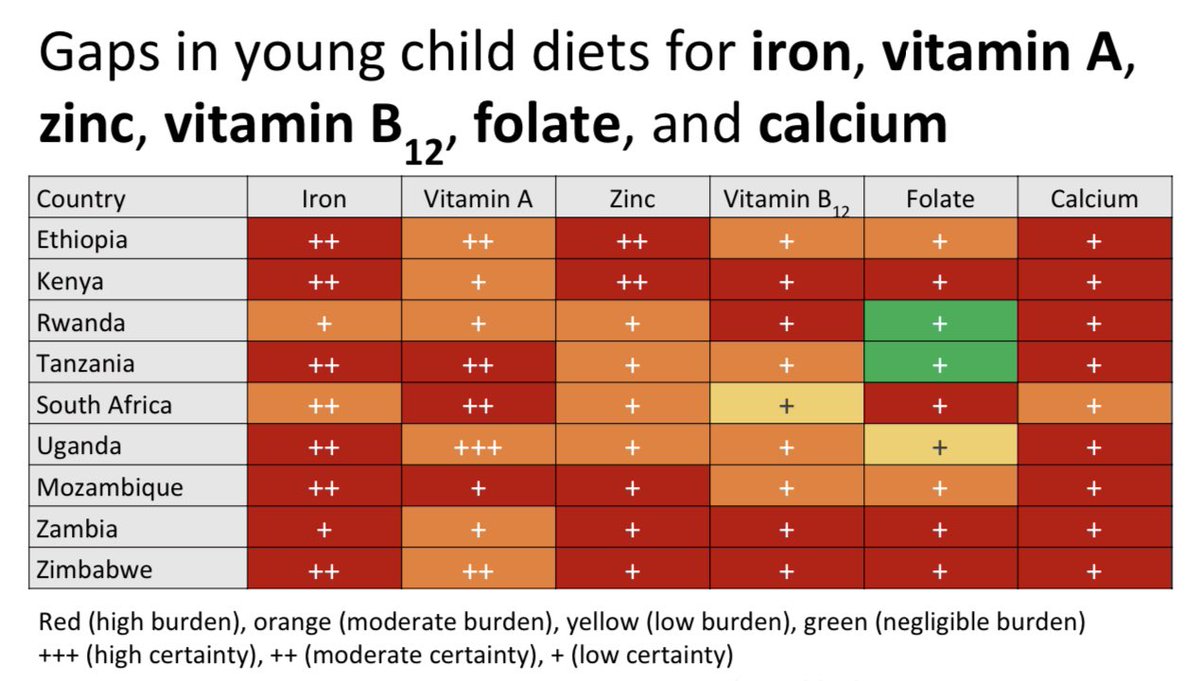
Here is a comprehensive ranking of foods by density in six nutrients commonly lacking globally
Top sources:
•Organs (liver, spleen, kidney, heart)
•Dark leafy greens
•Shellfish (crustaceans, clams, mussels, oysters)
•Fish, w/ bones
•Ruminant meat
•Eggs
•Milk/cheese
Top sources:
•Organs (liver, spleen, kidney, heart)
•Dark leafy greens
•Shellfish (crustaceans, clams, mussels, oysters)
•Fish, w/ bones
•Ruminant meat
•Eggs
•Milk/cheese

Here's a breakdown of the nutrient density rating by nutrient
Top iron sources:
•Organs (liver, spleen, kidney, heart)
•Small dried fish
•Bivalves (clams, mussels, oysters)
•Beef/goat
•Pulses (beans, peas, lentils)
•Traditional grains (fonio, teff, millet, sorghum)
Top iron sources:
•Organs (liver, spleen, kidney, heart)
•Small dried fish
•Bivalves (clams, mussels, oysters)
•Beef/goat
•Pulses (beans, peas, lentils)
•Traditional grains (fonio, teff, millet, sorghum)

Nutrient density rating
Very high: provides an average of 1/3 of recommended intakes with ≤ 1/6 of both energy & mass recommended intakes (assuming an energy density of 1.3 kcal/g)
Very high: provides an average of 1/3 of recommended intakes with ≤ 1/6 of both energy & mass recommended intakes (assuming an energy density of 1.3 kcal/g)
High: provides an average of 1/3 of recommended intakes with ≤ 1/3 of both energy & mass recommended intakes & with < 16.7% of either energy or mass recommended intakes (assuming an energy density of 1.3 kcal/g)
Moderate: provides an average of 1/3 of recommended intakes with 1/3–1/6 of both energy & mass recommended intakes (assuming an energy density of 1.3 kcal/g)
Low: provides an average of 1/3 of recommended intakes with > 1/3 of either energy or mass recommended intakes
For milk, the thresholds are based exclusively on energy, since it's easier to consumer larger quantities of liquids than foods
This analysis focuses on density in 6 micronutrients, and not essential fats or amino acids. As with all foods, those with high nutrient density may carry risks for non-communicable diseases, depending on the quantity, total diet and individual. Environmental impact not assessed.
@l_haddad @jessfanzo @Anne_Mottet @GAINalliance @drdairy50 @AgroBioDiverse @ILRI @fleroy1974 @GrassBased @mackinprof @kevinnbass @whsource @OsendpNutrition @laceyadunn @TamarHaspel @Dmozaffarian @MatthewJDalby @GHGGuru @wamasters @AnnaWHerforth @justjody23 @DrPatrickWebb
Thoughts? @bigfatsurprise @Mark_Sisson @ChrisMasterjohn @chriskresser @ProfTimNoakes @DaveKeto @lowcarbGP @KetoCarnivore @MarikaSboros @fatisourfriend @JoannaBlythman @KenDBerryMD @drmarkhyman @DietHeartNews @DiscoStew66 @tednaiman @SustainableDish @GoogleExpertUK
• • •
Missing some Tweet in this thread? You can try to
force a refresh










